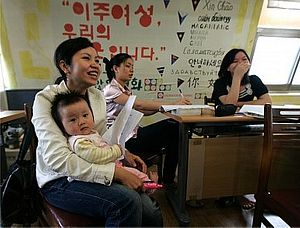A recent article in the Washington Post follows a Korean man and his Vietnamese mail-order bride and their journey to transnational holy matrimony. The couple depicted by the author is but one case in the thousands of international marriages in South Korea. The phenomenon of mail-order brides in South Korea and the issues that stem from it have in fact been developing for decades. Unfortunately, not all of these marriages have a fairy tale ending. As The Diplomat’s Tae-jun Kang has pointed out, some 69 percent of immigrant wives say they have experienced some form of abuse from their Korean husbands and international marriages frequently end in separation.
The steady influx of migrant brides in South Korea has less to do with a fantasy image of South Korean men from K-dramas than with unaddressed social issues in Korean society. The country’s rapid economic development, while impressive, has not escaped the social problems that stem from urbanization. Korea’s development has encouraged massive internal migration. Between 1945 and 1985 the urban population in Korea rose from 14.5 percent to 65.4 percent of the total population. Continued migration to the cities left rural villages impoverished, a problem that was not addressed by the New Community Movement (Saemaeul Undong), initiated by Park Chung Hee to modernize rural Korea and close the income gap between rural and urban areas. Today, Korea’s urban population stands at 81.90 percent of the total population, with the Seoul area alone home to around 20 percent.
Two problems that have emerged from this urban migration are extremely low fertility rates and the rural bachelor issue. Worried about a population explosion, the Planned Parenthood Federation of Korea began encouraging smaller families in the 1960s. By the 1980s families were being encouraged to have one child. This campaign was so effective that it is now a contributing factor in South Korea’s declining working-age population.
Meanwhile, young Korean women were moving in large numbers to the city, seeking work or further education. This in turn created the phenomenon of rural bachelors, whose struggles to wed was so extreme by the late 1980s that social organizations, churches, and even TV networks, began creating matchmaking programs. In the 1990s, some of these programs officially became state-led. After diplomatic and trade relations were established with China in 1992, the South Korean government saw ethnic Koreans in China (Chosunjeokin) as a solution to the rural bachelor issue and a means of offsetting the future economic effects of low fertility rate. Since then the number of international marriages, especially between Korean men and Asian women from China, Vietnam, and the Philippines has risen rapidly. Today international marriages account for 13 percent of all marriages in South Korea.
The mail-order bride phenomenon has now given rise to racial diversity in a society where racial homogeneity is still a source of pride. This is a worrisome predicament as until recently not much has been done on a wider scale to create a healthy environment that welcomes multiculturalism. The current policies regarding migrant women in South Korea focus on their roles as producers of Korean children rather than as citizens. Korea’s National Basic Livelihood Security Act (NBLS), which defines the recipients and content of the country’s welfare program, was last revised in 2005. While migrant women were included in this amendment, their legal entitlement to become beneficiaries of the welfare program defined by the NBLS is dependent on their ability to prove that they are “mothers” of their children. This is a reflection of how the instrumentation of maternity, which began to be used in 1970s family planning policy, is still a very prevalent theme in policymaking. Maternity, and by extension, migrant brides are an economic instrument for the government to ensure the availability of a future workforce.
There are now more than 100 multicultural support centers nationwide, offering various programs to help migrant brides at different stages of their lives in Korea, from marriage preparation to skills building. However, these programs have been criticized as inadequate in meeting the actual needs to migrant brides. The charming story presented in the Washington Post story offers a glimpse into a transforming South Korean society.
The South Korean government has recently tightened visa criteria for migrant brides, but it will need more sustainable policy solutions. Discrimination will not disappear by simply setting up Korean language and cooking schools. By 2020, the number of multicultural families in Korea is projected to reach 1 million. Much more needs to be done to embrace the approaching change.
Irene Yuan is a graduate of Yonsei Graduate School of International Studies in Seoul, South Korea and currently works for a non-profit in Washington D.C.

































